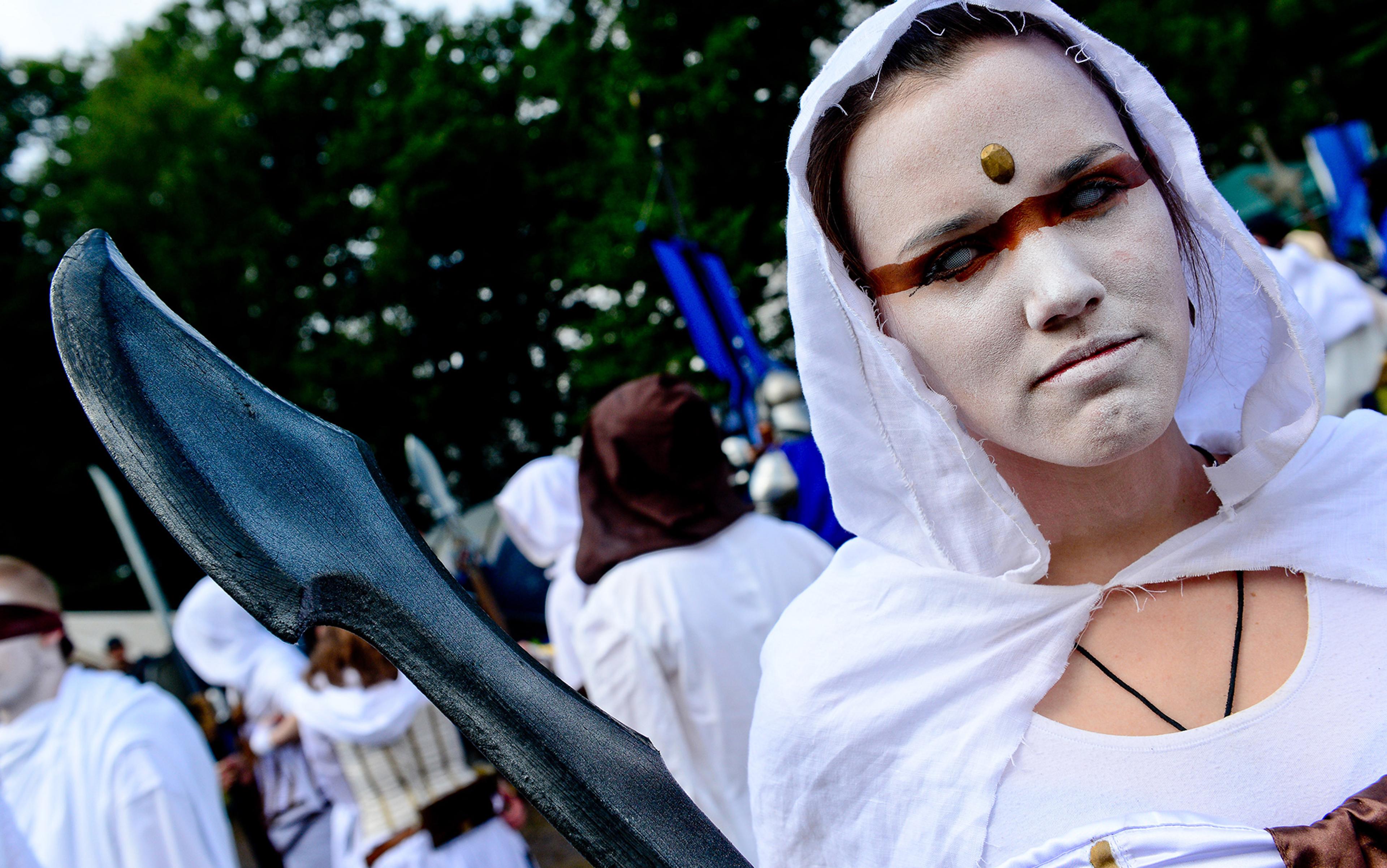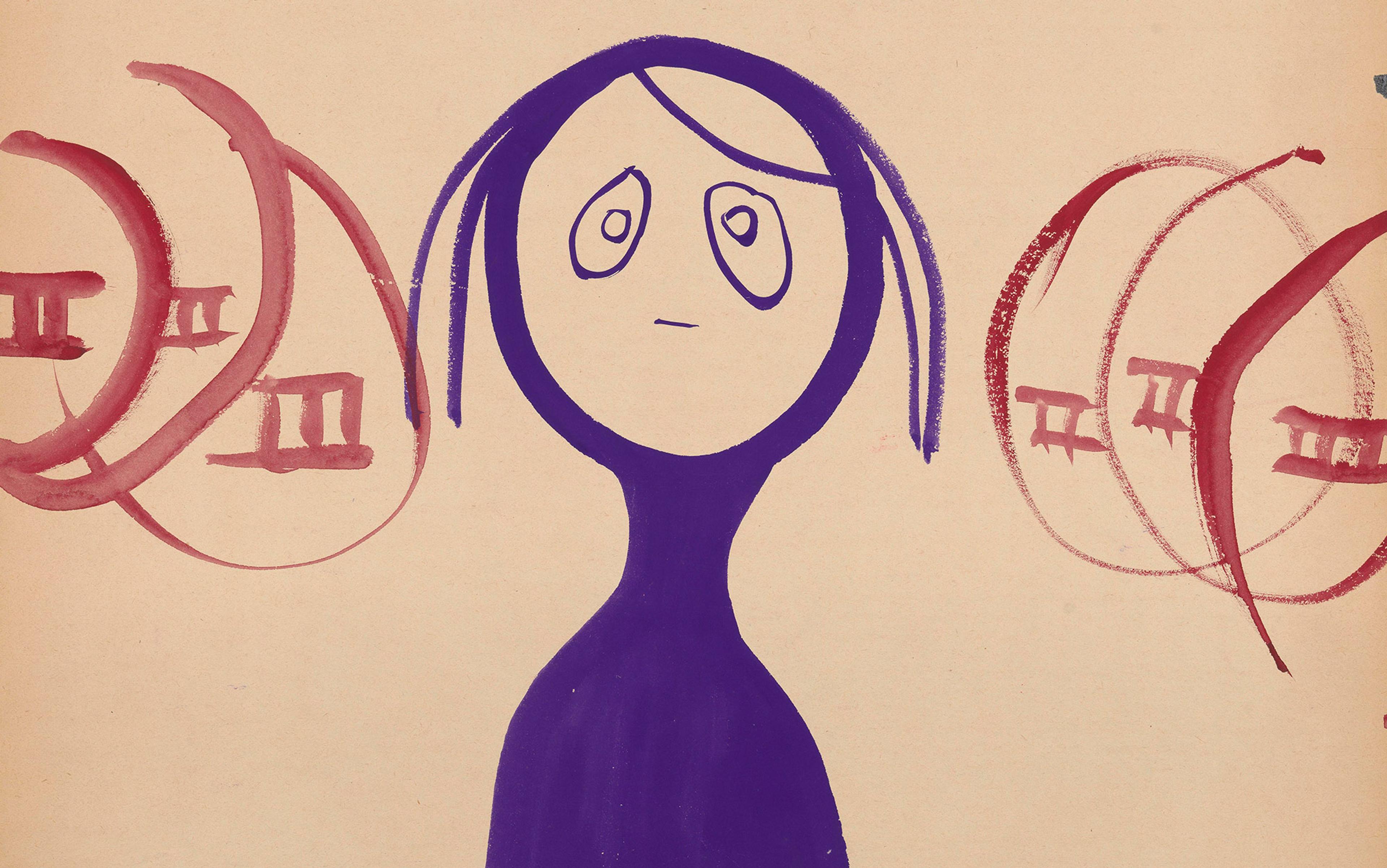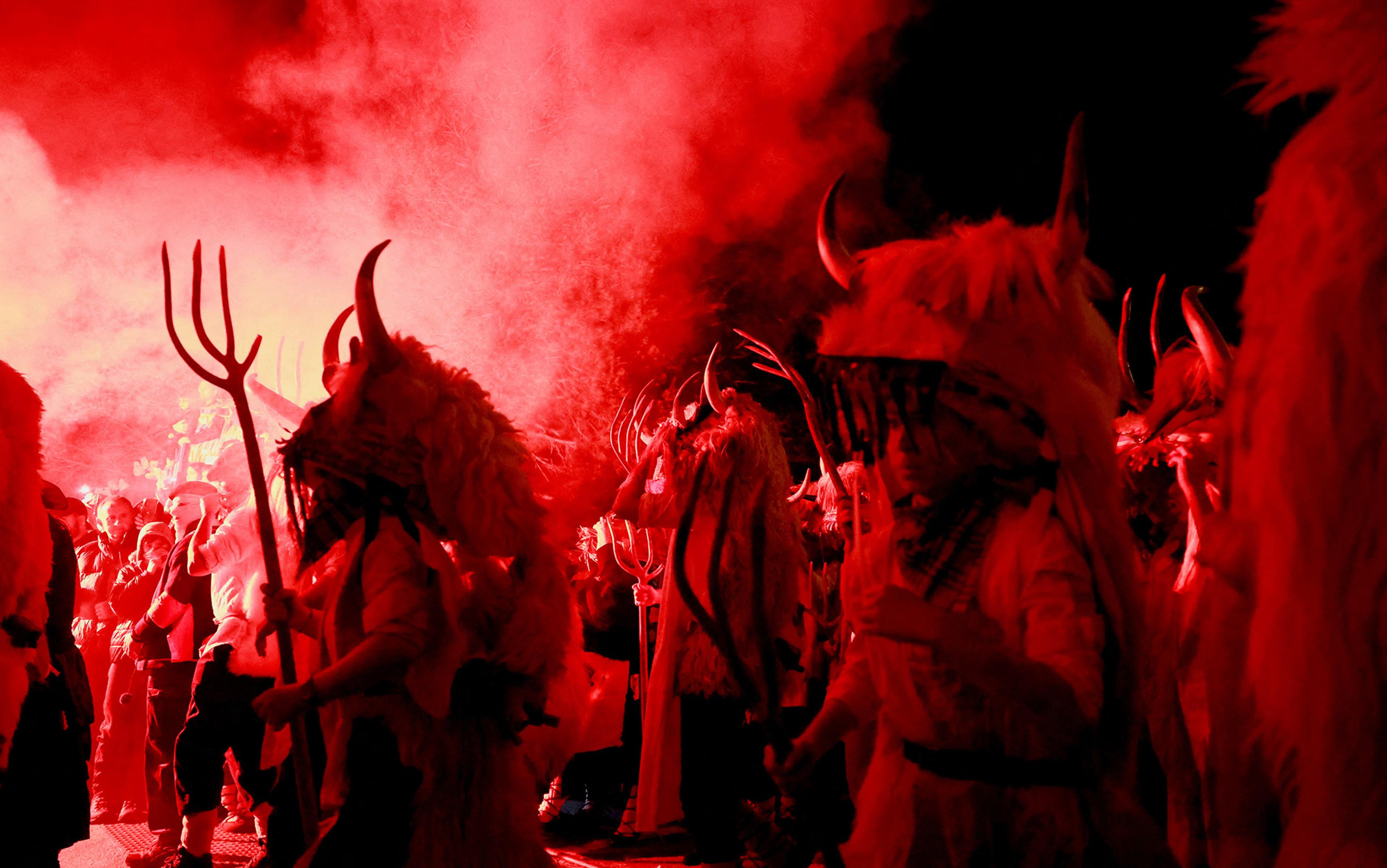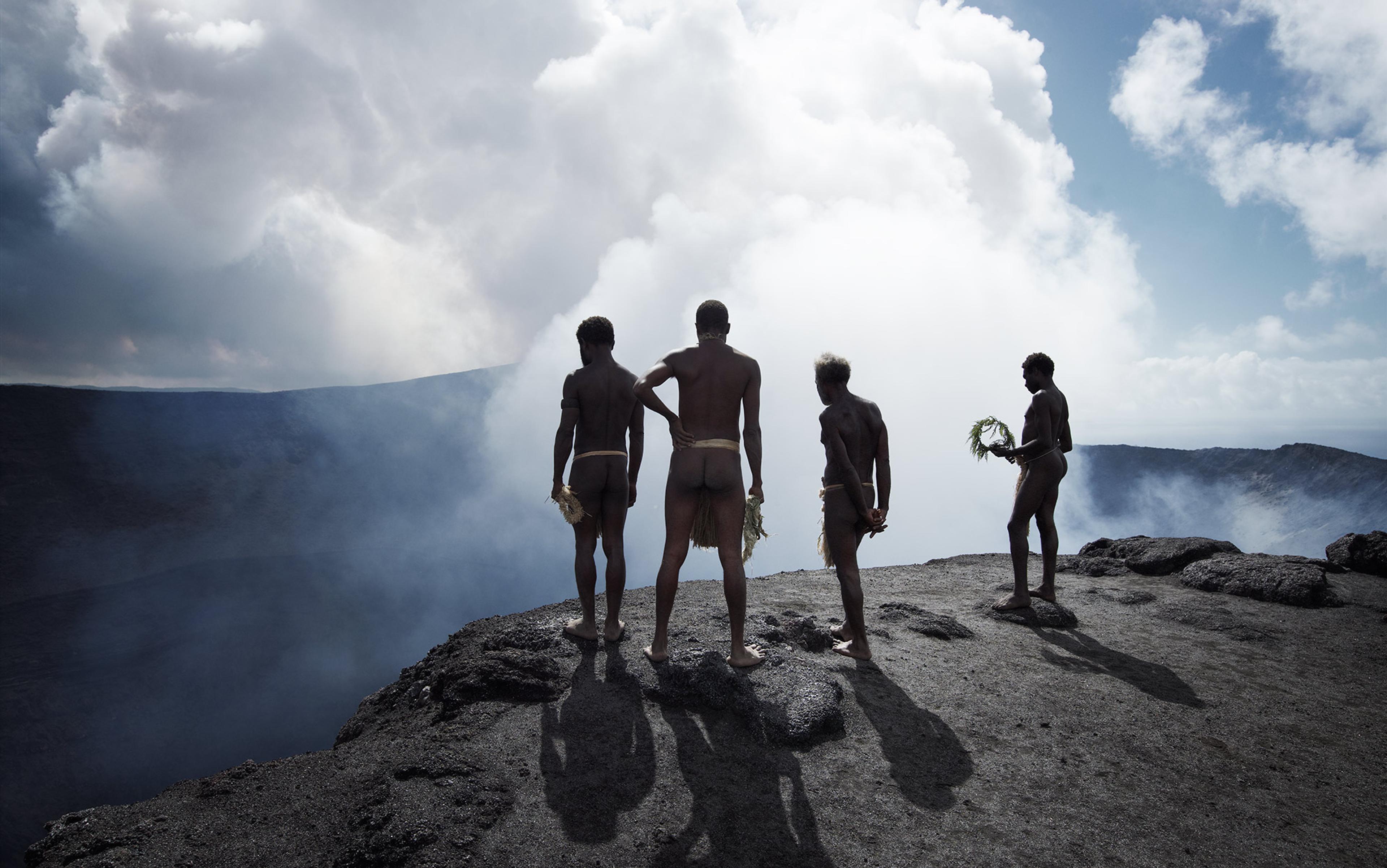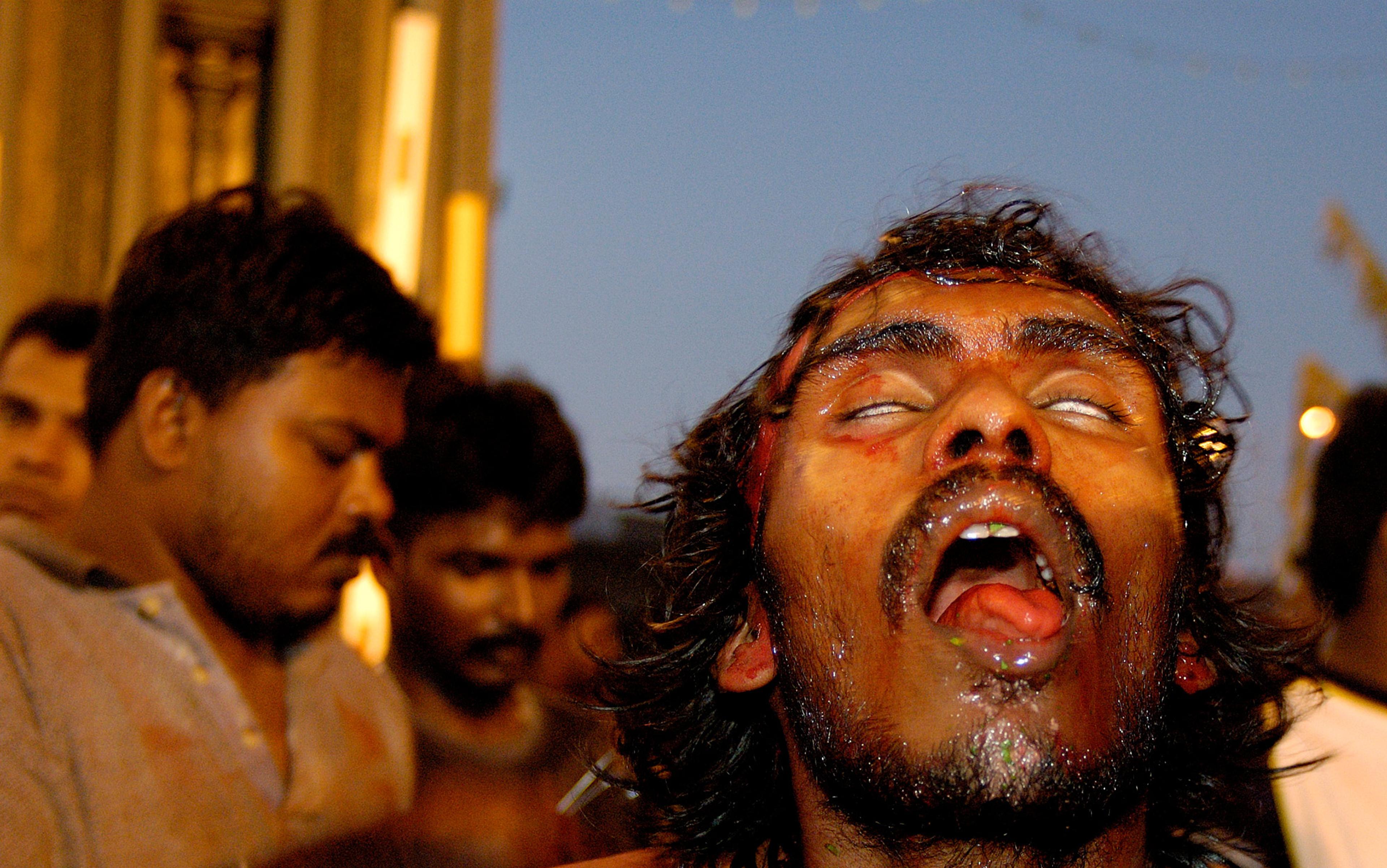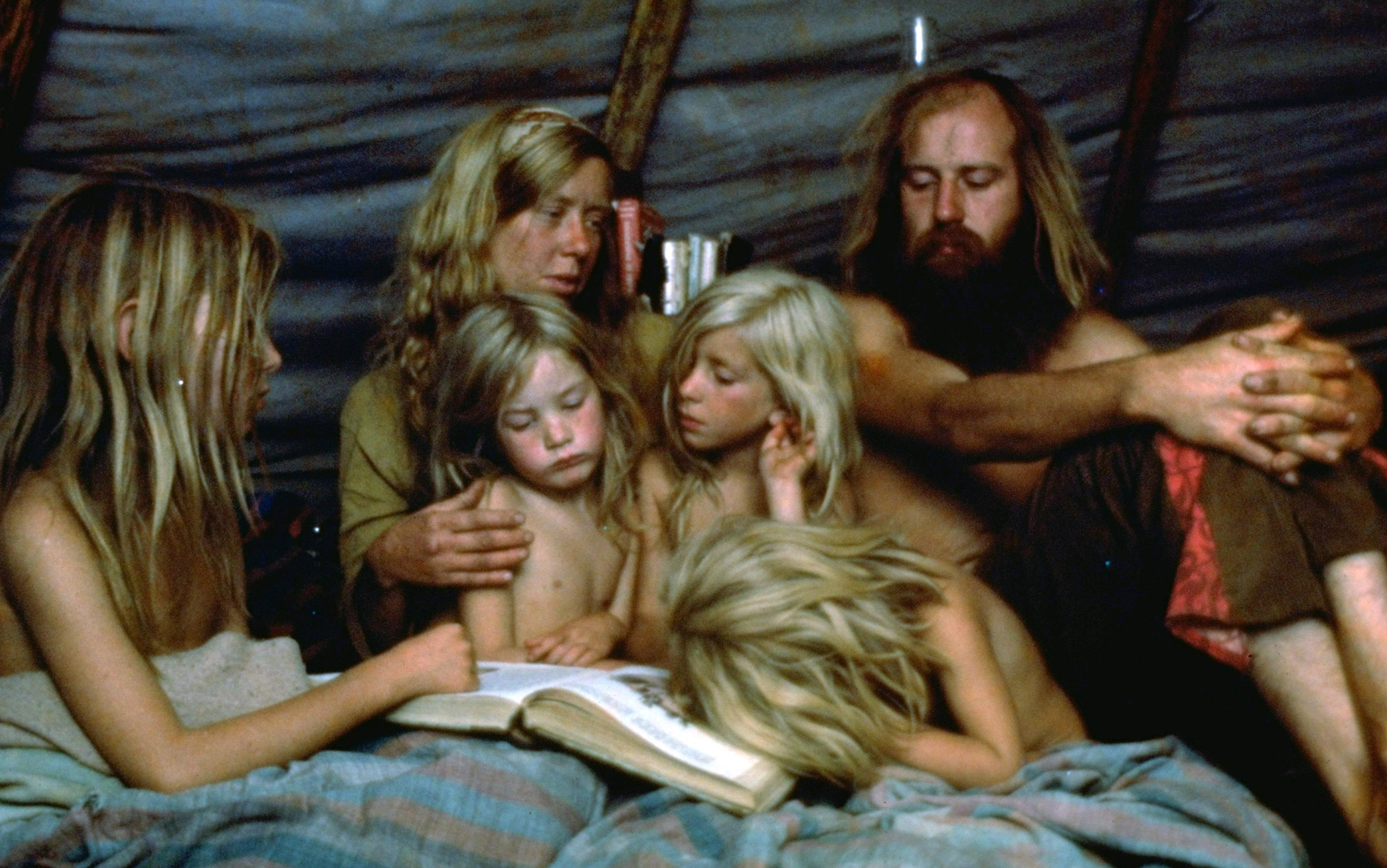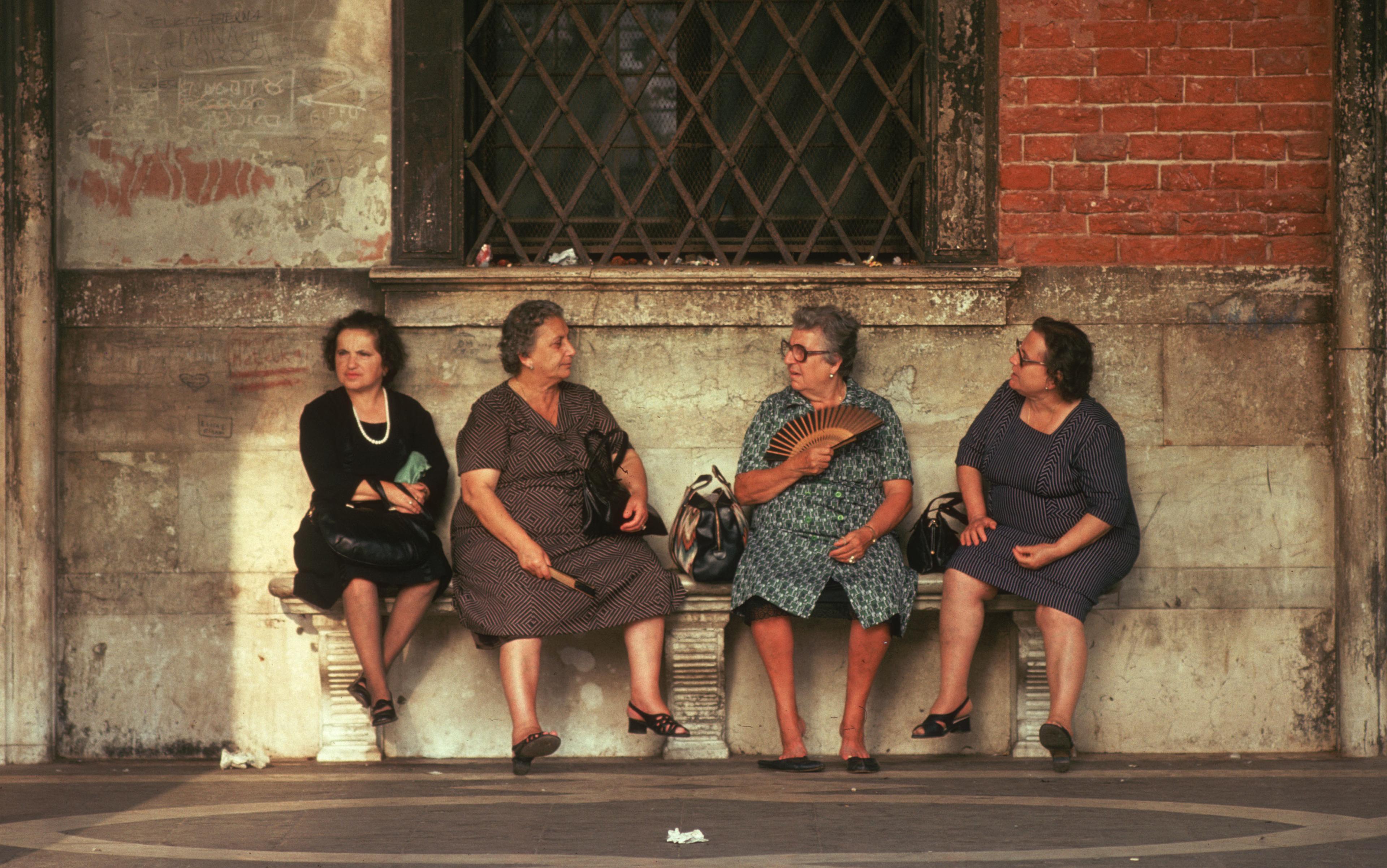One Sunday evening recently, I went to a stranger’s apartment for my first ‘larp’ (live‑action role-play). I was ushered into the living room, where I found three makeshift tents, reminiscent of forts I used to make as a child. Other props – trail snacks, water bottles, hiking gear – littered the floor. It was a little like arriving at a four-year-old’s playdate. I wasn’t sure my make‑believe skills were what they used to be. For the next few hours in that room in Oakland, California, I and five other brave souls would become immersed in The Climb, a game that had us imagine summiting a Himalayan peak 6,900 metres above the Tarphel Valley of Bhutan.
Six nametags lay on the floor. After much hesitation, I picked ‘Mercer: an internet zillionaire’. I’ve spent much time satirising the tech start-up scene, so this character wasn’t too much of a stretch. Profile sheets told us about our driving motivations and relationships with the other summiteers. Mercer had a crush on a character called Sweet, and had also funded the climbing expedition. All right then. One of my fellow climbers turned on the stereo, and an MP3 of snow-storm sound effects started to play.
The game was designed so that only two of the six players would be able to summit. Part of the drama would be selecting those two players. But the point of the exercise wasn’t to ‘win’ and be the one to summit. The point was to be present to the dynamics of the experience. We weren’t going to play The Climb. We were going to live it.
Larp had caught my attention as an interesting subculture. No longer just a medium for nerds running around in the woods with swords, it was increasingly billed as a vehicle for deep emotional exploration and cultural experimentation. In addition to the traditional Viking, vampire and zombie scenarios, larps have been designed around serious themes – refugee crisis, gender, homelessness, HIV/AIDS, imprisonment. As someone who cares deeply about social change and personal transformation, that was exciting to me. Larps were said to let players experience particular emotions, to step into each other’s perspective, possibly even explore artistic and political visions for new forms of society.
That sounded good to me. At college, I’d taken a course on radical economics. We’d read texts such as Fritjof Capra’s The Turning Point (1982) and Eduardo Galeano’s Open Veins of Latin America (1971), intended to purge us of the sins of classical and neo-liberal economic orthodoxies. But theory could take us only so far. On the last day of the course, we created a mini-barter economy. Each student was invited to bring a good or service into the course to trade. I brought a novella I’d written. Someone else brought socks they’d knitted. Another offered a Reiki massage. Then the market opened its doors.
What we soon discovered was that none of these goods were transferable or equivalent in value. I didn’t want to trade my writings for a pair of socks or a scented candle. While we’d demonised currency and come to worship the ideology of sharing and barter, here we were coming to terms with the functionality of money. It’s easy to become theoretically seduced, but ideas have to be lived experientially.
Larp was rumoured to be a powerful tool for transmitting theory into living practice. As the nomadic hacker and expert larper Eleanor Saitta told me, it makes you ask: ‘What does this feel like? What does this mean emotionally, rather than through an intellectual frame?’ It was time to find out.
That night in Oakland, I became Mercer. I fashioned myself into a sort of new-age billionaire investor, someone drinking the self-help Kool-Aid of positive thinking. I wanted to force-feed happiness to the world.
But other emotions kept intruding. Unexpected ones. As the billionaire, I felt isolated and out of touch. Summiting was just mind over matter, I insisted, forcing the other hikers to engage in visualisation exercises. I thought my entrepreneurial credentials could overpower my lack of actual summiting experience; that my formula for success in Silicon Valley would translate to any other context.
What surprised me was the aloofness I felt as a billionaire. I sat in one of the tents by myself feeling very lonely, brooding on my own (ie, Alexa Clay) fears of social ostracism. I was keenly aware of the artifice of my surroundings, frantically searching for things to do or say. But the other players made it real, transforming my private reactions into Mercer’s authentic experience. I really was cut off from the others. Unbeknown to me, one player in the game spread a rumour that I had murdered my wife, which I only learned when the game was over.
The most surprising thing was how much I had to be present, how I couldn’t dwell in the awkwardness of the make‑believe. I felt an enormous pressure to make the world exist for the others playing. Breaking character or allowing myself to wade in the social anxiety of the situation would destroy the game. Ordinary reality rarely requires such full participation and attention. Ironically, by faking reality, we somehow made it feel more real.
The social framework of the game seems to encourage an organised and sustained form of empathy
Saitta told me this anxiety to deliver is typical of shorter games. You don’t feel the same pressure in ones lasting days. ‘You stop having to try, and the reality [of the larp] just becomes baseline.’ But you are just as focused on the collective experience. So even in a longer larp where you’re not working to bring a fictional world into existence, you’re still aware of how your character and behaviours affect other players.
The social framework of the game seems to encourage an organised and sustained form of empathy. You identify with your character, and then you start to understand her world, and the world of others around you. This process can take you to some remarkably deep places. The Danish game designer Bjarke Pedersen and Saitta both recounted their experiences in a larp called Just a Little Loving, which they played together. First run in 2011 in Norway, the game is set in the Hudson Valley over a 4 July celebration during the 1980s AIDS epidemic. Its theme, Saitta tells me, is death and the fear of death.
Pedersen played a gay ‘bear’, who saw all his friends die around him. He said it felt important that he play the part respectfully. Before performing the role, he spoke to his brother and several gay friends. But even more than this research, he found that the game itself made him better engaged with AIDS and more aware of his privileges as a white heterosexual man.
‘The designers of the larp wanted to transmit this period in time to people that had no direct experience,’ Pedersen told me. ‘They wanted to help us collectively and viscerally remember and memorialise what happened.’ The other identity remains with him: ‘The emotions of that character are still inside me.’
Colin Fahrion, one of the strangers who invited me to the game in Oakland, has had similar experiences of heightened empathy. He says he’s played a lot of assholes in larps: it was interesting to step into the shoes of a sociopath or a narcissist. ‘It’s not who I am,’ he told me. ‘So it was a departure.’ A game called Sparkle, Baby! is themed around child beauty pageants. ‘You play the parents, and your child is represented by an inanimate object,’ Fahrion said. In the game, the character with the lowest economic status picks their ‘child’ last. When Fahrion played, the poorest parent got a daughter represented by a muddy shoe, wrapped in a plastic bag that symbolised a cheap dress.
Fahrion played a mother and narcissist who treated her child’s pageants as an excuse to buy herself new clothes. This mother would only acknowledge her child to admonish her, saying things like: ‘Be quiet, Mommy is talking now.’ Fahrion was fascinated to try on such a narcissistic personality. As he told me: ‘So often in fictional stories the villains are shallow… evil characters. It can be interesting and illuminating to play someone who embodies the complexities of what it means to be human, both good and bad.’
When the Belgian artist and scientist Angelo Vermeulen became the crew commander of HI-SEAS, a Mars mission simulation that had six pretend astronauts live for four months in a dome on a barren lava field in Hawaii, he was effectively engaged in a larp. During the mission, Vermeulen experimented with food production, leadership style (the crew rotated its leaders), and exercise regimes. NASA funded the research as a way of exploring future space‑colony design.
But why stop there? What if we had used role-playing games to model different approaches to banking and finance after the financial crisis? Or experiment with the use of crypto-currencies? What if we used pop-up temporary realities to explore the redistribution of resources or alternatives to the welfare state? At a time of growing alienation, larps can help us explore communitarian possibilities. Not ready to open your relationship, but interested in dabbling in non-monogamy? Try larping.
Role-playing provides the perfect way to temporarily ‘hack reality’, unchaining ourselves from the scripts of mainstream culture and conventional values to test new ways of being. The British cultural anthropologist Victor Turner wrote in From Ritual to Theatre (1982) about the power of experimental theatre and dance to enable ‘psychophysical re-training’. For Turner, this transformative possibility results from the ‘liminal’ space that emerges where to ‘make believe is to make belief’. And larp offers that in spades.
That said, isn’t there a risk that such explorations can only ever be a release valve for mainstream culture, a kind of carnival of licence that ends up reinforcing the boundaries of the workaday world? It’s one thing to inhabit a subculture temporarily, quite another to subvert dominant norms.
This was what society would look like if it were re-booted today
In September, I had an experience that was like a larp, only more so. I gathered with more than 100 ‘eco-hackers’ in a pop-up society at a chateau outside Paris. The event was called POC21. It was organised in opposition to the theoretical posturing of COP21, the United Nation’s Climate Conference in Paris this December.
Rather than talk theoretically or negotiate politically about climate change, hackers gathered to live in a low‑carbon‑footprint society, trading in the comforts of civilisation for compost toilets, camping and communal meals, while building open-source technologies such as DIY solar energy, wind turbines, co-budgeting tools, composting systems and greenhouses. This, I felt, was what society would look like if it were re-booted today. But the thing that surprised me the most was the sense of real community that emerged. My mind was full of strange, nostalgic thoughts about ‘tribal identity’ and localised belonging. I left the camp with a hunger for more communal living.
Perhaps an element of nostalgia is intrinsic to the role-playing experience – at least as long as it continues to evoke ancient, and now rather marginal, social forces. ‘There is a lot of ritual life that we don’t have any more. And [larp] could be a way to reconnect with that,’ said Jasmine Lyman, a Swedish designer who runs a lab where people test their role-play games. ‘Through larp we fill in the space for things that have been lost,’ she said.
The American game designer Nick Fortugno tells me he once brought together a group of predominately atheists to take part in This Miracle, a game he designed with Lizzie Stark. In the scenario, players create a religion from scratch. You play the role of a pilgrim and you make up origin stories, rituals, ethics and revelations. ‘People were profoundly moved by the experience,’ Fortugno told me.
Similarly, Pedersen, a passionate ‘larpwright’, has designed games based on esoteric cult worlds. His newest, Baphomet, takes place in 1937. He describes it as a ‘personal horror set in the vintage era’. Players are part of a hermetic order that disappears and is condemned to hell. The larp is an excavation into what happened. And for Pedersen, it’s a tool to ‘take people away from their scientific lives’; players have to be more magical in their thinking, ‘to understand what is around them… if someone is screaming on the floor, there could be a supernatural interpretation’. In this way, the larp is a detox from Western rationality, but also a way of accessing a more primordial consciousness. It’s not self-conscious.
In real life, Saiita explains: ‘Nobody laughs when you put a wafer on their tongue. Catholic mass is seen as a serious thing; whereas an equivalent ritual that has just been made up would be seen as weird.’ A ritual such as Communion has, she hypothesises, ‘accumulated past-ness’, which serves to normalise it. With larp, the meaning of every practice has to be explored because it has just been introduced. Ritual isn’t taken for granted.
It forces you to explore the rich array of possibilities for self-expression inside
Last year I joined a collective called Wisdom Hackers. We tried to ‘liberate’ different practices and rituals typically locked within the confines of particular religions and mash them up for secular experimentation. We held cacao ceremonies, talking‑stick circles and peer-to-peer shamanistic explorations. Of course, this divorcing of ritual from ethnographic context is part of a larger trend. Bikram yoga is practiced by professional urbanites. Zen meditation is taught in multinational companies to make employees more productive. There is no doubt something objectionable about this Western appropriation of ritual. Nevertheless, I like the thought of an interconnected age where tradition and spiritual practices are ‘open source.’
Within larp, this trend of cultural ‘scuba diving’ – of living out the rituals, experiences and practices of many different cultures – is all part of the fun. It’s a form of play that healthily destabilises your own world-view. And that forces you to explore the rich array of possibilities for self-expression inside. Who hasn’t gotten tired of playing themselves?
Rather than acting out the robotics of your personal identity, role-play allows you to discover hidden capacities. For the past three years, I’ve been playing a performance character I call the ‘Amish Futurist’. Through her, I wanted to voice my frustration and angst about the complacent techno-optimist attitude I saw all around me (bear in mind, I live in the San Francisco Bay area). So I went to start-up conferences dressed in a bonnet and prairie dress, and asked people Socratic questions about why they were developing a particular app or platform or, more generally, about what impact they felt technology was having on our lives. Through the Amish Futurist, I channeled a more sensitive, intuitive and moral voice than I had ever had the courage to try in the world.
Through this alter-ego, I learned that many of us have come to internalise and conform to a script of who we are that doesn’t necessarily permit the great elasticity of our being. As Fernando Pessoa noted in The Book of Disquiet (1984):
Each of us is several, is many, is a profusion of selves. So that the self who disdains his surroundings is not the same as the self who suffers or takes joy in them. In the vast colony of our being there are many species of people who think and feel in different ways.
Through larping, we can gain some familiarity with the different species we have inside us. And this is the great irony of these games: as much as you are escaping your ordinary existence, in many ways you are actually coming closer to truths about yourself and your society. The larp is a petri dish for human dynamics; it is the agar upon which you can grow colonies of multiple personae.
Fortugno told me how larping had taught him to be extroverted. As an introvert, he found that it cost him energy to talk to people. But then he started playing a game called Seasons of Darkness in which he played the character Laurence. ‘Whenever Laurence is nervous, uncomfortable or upset,’ Fortugno said, ‘he runs to the biggest group of people and tries to make them like him.’ So Fortugno had to learn techniques for making people laugh or pay attention when he was talking. In effect, he trained himself in extraversion. ‘It was sort of like therapy,’ he said. Now he thinks of himself as an extrovert – and behaves like one, too. When I met him at a storytelling retreat in Montauk, New York, there was nothing about him that would have suggested shyness. He was sociable and charming, even amid a group of relative strangers.
It was essentially a fairy-tale larp for human-trafficking survivors: the fairies needed the players’ help to re-open the door to the fairy world
In the world of larp, this experience of your character spilling over into your real life is called ‘bleed’. It’s quite common. Fortugno remembers another character he played called Willy, who was very unpopular in the game: ‘I would show up and everyone hated me.’ So Fortugno started debriefing exercises to make sure he deliberately connected with his fellow players outside of the scenario so that he could remind himself he wasn’t really hated. ‘The issue is bleed,’ he said. ‘My emotions are not cerebral. If I’m upset in my character, my emotional life doesn’t know it’s a character. So if I act self-destructively, for example, I have to process that so that the self-destructive impulses don’t stay in my body when I leave the game.’ There were several larps that left him depressed for weeks.
So the process is not without its dangers. But larps are carefully designed to create safe and therapeutic environments. Fortugno taught a class that was essentially a fairytale larp for human‑trafficking survivors. The premise was that fairies needed the players’ help to re-open the door to the fairy world. Players completed creative puzzles to aid the fairy mission. Each involved the players figuring out something, such as a song or sculpture or piece of writing. The game was explicitly not trying to cure trauma, but teaching socialisation, safety and re-awakening the imagination.
As in other role-playing environments, safe words and signals are used, allowing players to pause and check in with each other to make sure everyone is OK. One of the golden rules is ‘de-roling’ – making sure that people talk to each other as themselves after a game. After The Climb, for example, we took turns sharing our experience and complimenting each other’s performances. It felt cathartic. I had entered the room with strangers. Leaving, I felt a deep connection with the other players. We had lived out an experience together. Was it the type of closeness we might have felt had we really summited a mountain? Perhaps. As one of my fellow players put it: ‘I got this wonderful feeling of, I don’t know, inclination toward people post-game. It felt a bit like after playing a team-sport with people.’
Weddings, zombie dystopias, occult orders, hiking the Himalayas – larps have all the ingredients for heightening human agency – tools for designing social dynamics, for elevating empathy and self-awareness, for living out alternative cultures. From the outside, it’s hard to appreciate the profound emotional experience it creates. Larp is not merely a therapeutic outlet for individuals. It’s a blank canvas for our systems and the cultures we inhabit.
